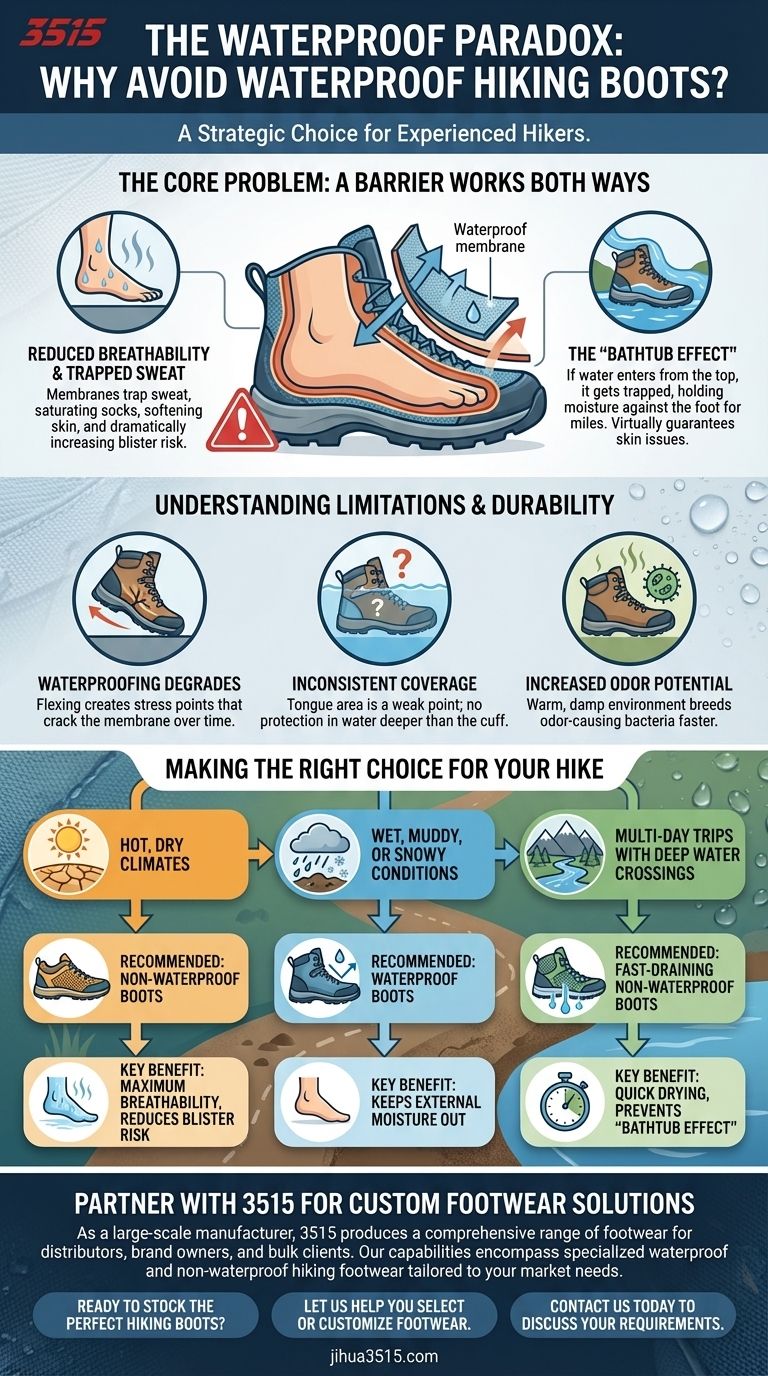While seemingly a universal benefit, avoiding waterproof hiking boots is a strategic choice for many experienced hikers. The primary reasons are that waterproof membranes significantly reduce breathability, which traps sweat and can lead to blisters. Furthermore, once water gets inside a waterproof boot—by flowing over the cuff—it takes far longer to dry out than a non-waterproof alternative.
The core trade-off of waterproof footwear is that the barrier designed to keep water out also traps moisture in. This can turn a boot from a protective asset into a liability, especially in warm conditions or when a full submersion occurs.

The Core Problem: A Barrier Works Both Ways
A waterproof boot typically uses a membrane (like Gore-Tex) with pores too small for liquid water to pass through but large enough for water vapor (sweat) to escape. In theory, this is ideal. In practice, the physics of moisture management are more complex.
Reduced Breathability and Trapped Sweat
No waterproof membrane is as breathable as a simple mesh or fabric upper. On a warm day or during strenuous activity, your feet produce a significant amount of sweat.
A less breathable boot cannot vent this moisture vapor fast enough. This trapped sweat saturates your socks, softens your skin, and dramatically increases the risk of friction and blisters.
The "Bathtub Effect"
The biggest drawback emerges when water gets inside the boot, most commonly by flowing over the top during a deep stream crossing.
A non-waterproof boot would drain almost immediately. A waterproof boot, however, traps that water inside. This creates a "bathtub effect," holding water against your foot for miles and virtually guaranteeing skin issues.
Significantly Slower Drying Times
Because the waterproof membrane inhibits airflow, a saturated waterproof boot takes exponentially longer to dry. This is a major problem on multi-day treks where you cannot afford to start the day with wet footwear.
In contrast, a non-waterproof mesh boot can often dry substantially while you wear it, using your body heat and ambient airflow.
Understanding the Limitations and Durability
Beyond the fundamental trade-off of breathability, the waterproofing technology itself has inherent limitations that are important to understand.
Waterproofing Degrades Over Time
The waterproof membrane is a physical layer within the boot's construction. Over hundreds of miles, the constant flexing of the boot, especially in the forefoot, creates creases and stress points that eventually degrade and crack the membrane, rendering it ineffective.
Inconsistent Coverage and Weak Points
Waterproofing is not always absolute. The tongue area is a common weak point where designs can fail. A boot is also only waterproof up to the height of its cuff, offering no protection in water deeper than that.
Increased Odor Potential
The warm, damp, low-circulation environment inside a waterproof boot is an ideal breeding ground for odor-causing bacteria. They often develop and retain odors more quickly than their more breathable counterparts.
Making the Right Choice for Your Hike
The decision to use waterproof boots should be based entirely on the anticipated conditions of your hike, not on the assumption that "waterproof" is always better.
- If your primary focus is hiking in hot, dry climates: Choose non-waterproof boots for maximum breathability, which is the key to comfort and blister prevention.
- If your primary focus is hiking in consistently wet, muddy, or snowy conditions: Waterproof boots are the correct tool to keep external moisture out and your feet warm and dry.
- If your primary focus is multi-day trips with expected deep water crossings: Consider highly breathable, fast-draining non-waterproof boots or trail runners that will get wet but also dry very quickly.
Ultimately, choosing the right footwear means matching the technology to the environment, not the other way around.
Summary Table:
| Scenario | Recommended Footwear | Key Benefit |
|---|---|---|
| Hot, dry climates | Non-waterproof boots | Maximum breathability, reduces blister risk |
| Wet, muddy, or snowy conditions | Waterproof boots | Keeps external moisture out |
| Multi-day trips with water crossings | Fast-draining non-waterproof boots | Quick drying, prevents 'bathtub effect' |
As a large-scale manufacturer, 3515 produces a comprehensive range of footwear for distributors, brand owners, and bulk clients. Our production capabilities encompass all types of shoes and boots, including specialized waterproof and non-waterproof hiking footwear tailored to your market needs.
Ready to stock the perfect hiking boots for your customers? Let us help you select or customize footwear that matches your target market's specific environmental conditions. Our expertise in both waterproof and breathable technologies ensures you get the right product mix for maximum customer satisfaction.
Contact us today to discuss your footwear requirements and discover how 3515's manufacturing capabilities can enhance your product lineup!
Visual Guide

Related Products
- Safety Footwear Wholesale Manufacturer for Custom OEM/ODM Production
- High Performance Fire-Retardant Waterproof Safety Boots
- Premium Wholesale Waterproof Safety Boots High Performance Protection for Industrial Markets
- Factory Direct Wholesale Rain Boots Durable Waterproof & Fully Customizable
- Wholesale High-Traction Camo Boots - Custom Manufacturer for Brands
People Also Ask
- What are OSHA approved shoes? Understanding the Correct Standards for Workplace Safety
- What cultural and environmental considerations are tied to wearing shoes indoors? Balance Hygiene, Tradition, and Foot Health
- How long can you wear safety boots? The Lifespan is Determined by Wear, Not Time
- What are the differences between steel toe, composite toe, and alloy toe Wellington boots? Choose the Right Safety Toe for Your Job
- How do safety shoes contribute to cost savings for companies? A Strategic Investment in Risk and Cost Management



















